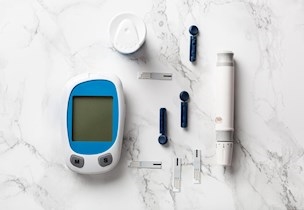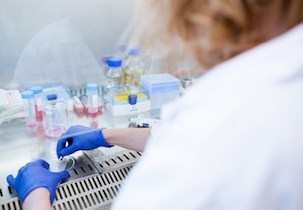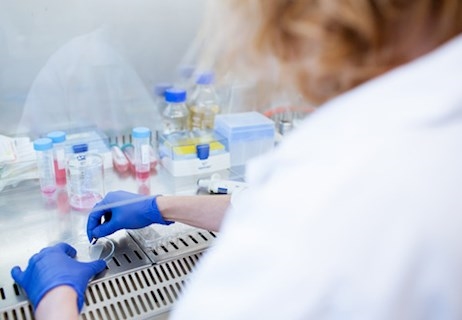Biotech, pharma and medical devices
The pressure on biotech, pharma and medical device companies to deliver innovative, sustainable products to the market fast, is growing. This calls for new, technology driven solutions.
Shorter product life cycles, shorter development cycles and shorter time-to-market processes all challenge the way pharmaceutical, biotech and medical device companies operate. Looking ahead, there are tough questions that need to be addressed, such as:
- What will end users in the future demand from your products and services?
- How will technological shifts change product development processes?
- How do you harness digital technologies in production lines and processing equipment?
- How do we as industry ensure data ethics and data security in a complex array of ecosystems?
- How can you meet and integrate the growing portfolio of regulation?
- How will green transition and the sustainability agenda affect the way your business develop?
We want to help you choose and leverage strategies and technologies that optimise your business and ensure future readiness.
See how we can help in the following areas:
Improving time to market for pharma, biotech and medtech products
Time to market is crucial to stay competitive — shortening R&D cycles, rapidly evolving technology, growing risk awareness, increased user involvement, and expanding end user requirements all contribute to the need for robust processes and smart use of technology, such as automation, simulations and virtual prototyping that can ensure fast launches of products that are a good market fit. And when it comes to connected devices, for example for remote monitoring of equipment and patients, and app-based solutions, cyber security is key.
- The road to greener medical devices
Increased environmental focus will stimulate more regulatory requirements for medical products - something we as a manufacturer already should address. - Simulation driven product and process development
Save time and cost by implementing simulation studies in the design phase of products and process equipment. - Cyber security screening of products
How do you ensure that products with built-in software, fx medical devices, are adequately secure for their entire lifetime? - Risk and safety management when developing medical devices
Three key questions to help you manage risk and safety during development and launch of medical devices. - IoT as driver for a digital health sector
How can connected devices and sensors support and assist fx. hospital logistics and operations and monitor patients and critical equipment? - Remote monitoring of patients in the healthcare sector
Increased use of remote monitoring in the healthcare sector requires interoperability of healthcare data in the electronic platforms - Life cycle assessment (LCA) of products and services
Make decisions about how to reduce energy consumption and climate impact, and reduce waste, with LCA. - Case: Glostrup Hospital - technological innovation that respects the users' context
How user involvement and ideation processes led to development of new technological solutions for fx. communication and automatic registration of patients and materials.
Optimising production processes
Manufacturing is complicated business, and when products meet strict regulatory requirements, the complications multiply. Unplanned downtime or product quality issues can result in critical delays in the production output or even withdrawal of permission to market and sell a product in a given market.
Process optimization, regulatory requirements, product quality and market needs, as well as the overall cost and environmental impact, have to be taken into account when designing, sourcing, commissioning and operating a production facility for pharmaceutical and biotech products, and medical and health tech equipment.
A facility design that is fit for purpose, fx. through hygienic design principles for processing of liquids, and with focus om monitoring, maintenance and maintainability, will not only ensure a good initial design, it will also help secure a healthy TCO of the facility and maintain a good through-put.
-
Wireless communication and industrial systems
Reliability is key when introducing wireless technology for fx. control systems or component monitoring industrial systems. The choice between wireless and wired communication, or a combination, depends on the use case and requirements specification. - Calibration of flow meters
Minimise risk of errors in measurements, ensuring production quality and approval. - The broadest measuring range within vacuum calibration in Denmark
Get high assurance for the precision in production processes involving fx. freeze drying - Re-manufacturing
Utilising intelligent repair- and re-manufacturing methods, the service-time of valuable components can be extended, saving time and money. - Hygienic design is important in production equipment of the future
Hygienic design ensures rapid, effective cleaning of processing equipment, ensuring that products are of high, uniform quality and optimising the consumption of water, energy, and cleaning chemicals . - Centre for Hygienic Design
Consultancy and validation services for hygienic design, cleanliness, and the lifetime of process and production equipment.
Ensuring market access
The market for pharmaceuticals and medical equipment is heavily regulated, and focus on formal requirements, standardisation, compliance and test is imperative in the production and marketing of the products.
Not only do the final products and the components and ingredients have to be tested and approved meticulously, there are also specific requirements for the approval, quality, marking and design of the facility and equipment used to manufacture the products, as well as compliance to specific standards.
- Case: Medical device manufacturer Dansac focuses on compliance
Achieving compliance with regulatory requirements and standards is a resource-intensive effort for medical device manufacturers. Dansac found a short cut that optimised their quality assurance competencies. - Product approval of medical devices
You need to take the legal requirements for approval of medical devices into consideration throughout product development. - Chemical test of personal protective equipment
Accredited tests ensure that your personal protective equipment meets the specifications of current standards - Sound quality listening tests and benchmark tests
Document the sound quality of fx. hearing aids and medical device alarms with independent listening tests.
Build a robust supply chain
Knowledge about and monitoring and tracking of supply chains using fx. IoT can give new information to help optimising supply chains, as well as be the basis for new services and business models.
- Advanced real-time monitoring in supply chains
How will we monitor and control our supply chains in the future?
On-demand webinars

What are the life science industry’s biggest technological challenges?
New report maps the technological challenges with digitalization and green transformation in life science companies.Cases and articles from the life science industry

Sustainable medical devices
/Article
Life science newsletter
Sign up and learn about technological innovation and solutions within the life science industries.
— News
— In-depth articles
— Case studies
— Invitations to events and webinars



